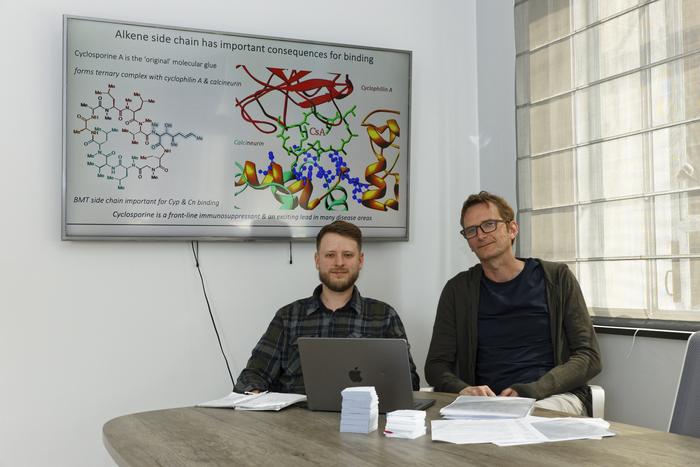Alkenes, defined by their characteristic double carbon-carbon bonds, serve as fundamental building blocks in organic chemistry. Found ubiquitously across pharmaceuticals, agrochemicals, and materials science, these molecules offer rich versatility. However, until now, the incremental extension of alkene chains by singular carbon atoms has posed significant challenges due to the multistep and laborious nature of traditional synthetic routes. The Cambridge team’s pioneering one-carbon homologation process elegantly circumvents these obstacles, enabling rapid, selective molecular augmentation.
At the heart of this transformation lies an ingenious chemical reagent—a cleverly designed allyl sulfone derivative functioning as a “one-carbon transfer agent.” This reagent facilitates a cascade whereby it initially covalently attaches to the alkene substrate, triggering a controlled sequence of bond reorganization. The reaction culminates in the integration of precisely one carbon atom into the substrate’s backbone. This process operates under mild conditions in a single pot, markedly reducing synthetic complexity and time investment compared to classical methods.
.adsslot_zLIN0lAuYj{ width:728px !important; height:90px !important; }
@media (max-width:1199px) { .adsslot_zLIN0lAuYj{ width:468px !important; height:60px !important; } }
@media (max-width:767px) { .adsslot_zLIN0lAuYj{ width:320px !important; height:50px !important; } }
ADVERTISEMENT
Professor Matthew Gaunt and Dr. Marcus Grocott, leading the Yusuf Hamied Department of Chemistry team, emphasize the conceptual novelty: “While alkenes are abundant and structurally important, a facile, selective route to insert just one carbon atom into these molecules remained elusive. Our reagent’s modular design confers unique control over both reactivity and selectivity.” The modularity is evident, as each segment of the reagent is tailored to execute a specific function, from substrate recognition and binding to initiation and termination of the carbon insertion sequence.
The versatility of this method is underscored by its compatibility with a broad array of alkene substrates, spanning diverse structural classes and functional groups. Such tolerance greatly expands the chemical space accessible through homologation, enabling chemists to traverse molecular architectures more creatively and efficiently than before. This expands not only synthetic toolbox but also strategic possibilities in pharmaceutical chemistry and beyond.
In a particularly compelling demonstration of practical utility, the team applied their technology to the immunosuppressive agent Cyclosporine A, a complex cyclic peptide widely used in transplant medicine. Through incremental addition of one or two carbons, they generated novel analogues which exhibited varied binding affinities and immunomodulatory activities. Intriguingly, some analogues maintained the capacity to bind target proteins and modulate immune response, while others selectively diminished immunosuppressive effects, suggesting pathways toward fine-tuned therapeutic modulation.
This precision editing at the molecular level exemplifies the transformative potential for medicinal chemistry. Fine control over molecular composition and length directly translates into modulation of pharmacodynamics and pharmacokinetics—critical factors in optimizing drug candidates. With the ability to explore “chemical space” with such granularity, chemists can now design drug analogues that might achieve enhanced efficacy, reduced toxicity, or tailored biological profiles.
Moreover, the route holds promise well beyond pharmaceuticals. In agrochemical design, subtle alterations to molecular carbon frameworks can dramatically influence properties such as bioavailability, environmental stability, and target specificity. Similarly, in materials science, precisely extended carbon chains can modulate polymer properties, influence surface interactions, and enhance functional performance. This methodology thus opens broad industrial avenues.
Underlying this advancement are sophisticated mechanistic insights into the dynamic behavior of the allyl sulfone reagent. Kinetic studies reveal how particular structural elements orchestrate the timing of bond formation and cleavage, ensuring high selectivity. The process is reminiscent of a precision molecular “assembly line,” where each step is choreographed to yield the desired product without side-reactions. This level of control is unparalleled in homologation chemistry.
The Cambridge team’s approach contrasts starkly with classical methods requiring multiple protective group manipulations, sequential functional group interconversions, and harsh reaction conditions. By embracing a catalytic, single-pot design, the methodology embodies the principles of green chemistry—minimizing waste, energy consumption, and procedural complexity. This aligns seamlessly with contemporary drives toward sustainable and scalable synthetic approaches.
Dr. Grocott reflects on the broader significance: “Our platform is more than a synthetic shortcut. It’s a conceptual leap that enables chemists to design and construct molecules with an extraordinary level of precision. This capability can accelerate not only the pace of discovery but also the depth of innovation across chemical disciplines.” Such statements underscore the paradigm shift embodied by this work.
The work’s timely publication in the journal Nature signals its exceptional impact on the scientific community. As researchers worldwide digest and adopt this technology, a cascade of novel synthetic strategies and applications is anticipated. Its integration into medicinal chemistry programs promises to expedite the translation of molecular designs from concept to clinical candidates, ever critical in an era demanding rapid response to emerging health challenges.
Ultimately, this advancement epitomizes the power of thoughtful molecular engineering, where design meets function to surmount longstanding obstacles. By granting chemists a robust, facile tool for one-carbon extension of alkenes, the Cambridge team has firmly positioned themselves at the vanguard of chemical innovation—opening a gateway to molecules previously deemed inaccessible and redefining the frontiers of chemical synthesis.
Subject of Research: Chemistry – One-carbon homologation of alkenes
Article Title: One-carbon homologation of alkenes
News Publication Date: 20-May-2025
Web References: https://www.nature.com/articles/s41586-025-09159-9
References: DOI: 10.1038/s41586-025-09159-9
Image Credits: Credit: Michael Webb
Keywords
Chemistry, Molecular chemistry, Molecules
Tags: alkene molecular modificationallyl sulfone derivativecarbon atom insertion methoddrug discovery implicationsefficient chemical synthesismolecular framework transformationone-carbon homologation processorganic chemistry innovationspharmaceuticals and agrochemicalsstreamlined reaction techniquessynthetic chemistry breakthroughUniversity of Cambridge research





